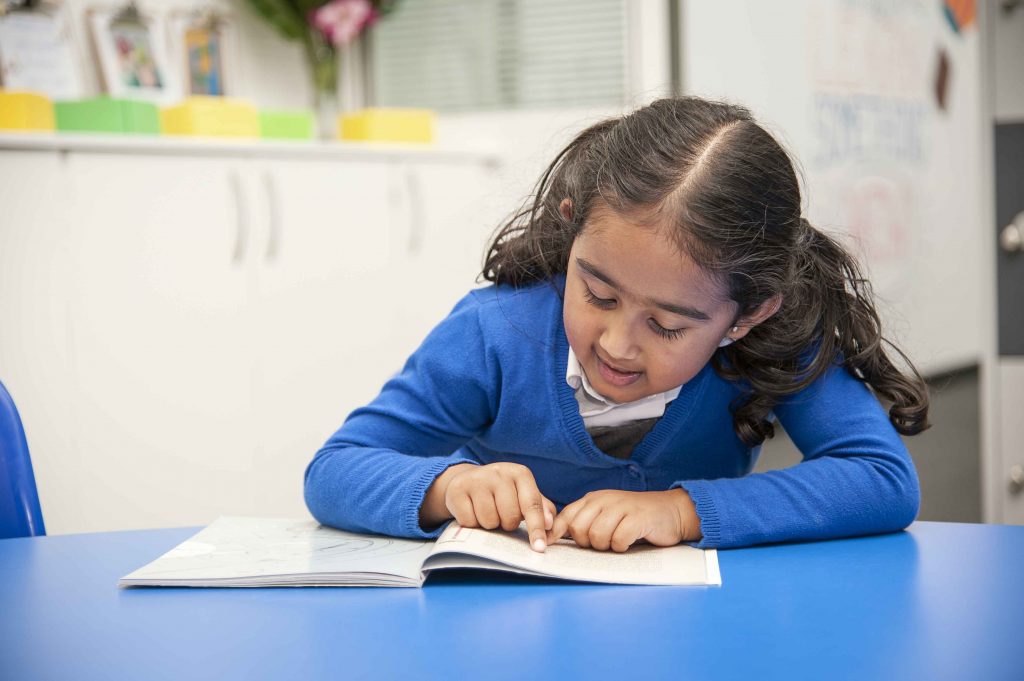You’re creating a new reading programme. The first question you ask yourself is, ‘How can I get all children to read as quickly as possible?’ You know that the more quickly they learn to read, the sooner they’ll read fabulous books for themselves. You want the success of your reading programme to be judged on the speed of its redundancy – whether they’re learning to read at five or catching up at seven.
You’re taking full notice of the new National Curriculum (NC), and in particular that, while children are learning to read, they should:
“Read aloud accurately books that are consistent with their developing phonic knowledge, that do not require them to use other strategies to work out words [and] re-read these books to build up their fluency and confidence in word reading.”
This is important – you can’t rely on all parents to help, so you’ll need children to be able to read the books for themselves. This also makes sense to those parents who do help.
You know the importance of reading fabulous stories (real books) to children every day, encouraging them to join in with the refrains and learn many shorter books by heart.
You’ve read the recent neuroscience research on how children learn effectively, so you know to:
1. Focus on one new thing at a time;
2. Build up your programme incrementally, connecting new learning with prior knowledge
3. Help teachers judge children’s Goldilocks spot, so they can make their reading lessons not too easy and not too hard
This is what I did:
I created a programme that teaches the English alphabetic code. I used picture mnemonics to teach children to read and write letters for the sounds, used a frog puppet to get them blending, and gave them books that matched the letter-sound correspondences they’d learnt so far. (I included a few irregular words and, to avoid confusion, highlighted them in red.) Children read the storybooks two or three times, each with a different focus, and then take them home to read. In schools that follow the programme faithfully, children can read independently within two or three years – whether or not they have someone at home to help them.
Goodbye reading scheme stories. Hello the world of books.
Other creators have done something similar. However, we – the phonic people – tell schools to stick to one scheme, particularly at the start, because we introduce the sounds in different orders, use different ways to teach the sounds and match our books to our own order of sounds.
However, earlier creators of programmes used other systems to try to teach children to read.
Some used a ‘Look and Say’ approach, building up key words a few at a time and repeating them in their storybooks.
Others wrote books where children were expected to guess from pictures: ‘I can walk, I can fly, I can cycle.’
Whatever the system chosen, each creator made a decision about how they were going to teach children to read.
What is Book Banding?
Book Banding is an offshoot of Reading Recovery.
All the reading schemes from the last four decades were put into one pot and repurposed into a whole new approach.
All the schemes were sliced into slivers, horizontally: the earliest levels went into the first band. The next levels went into the second, and so on until there were no more books. ALL the schemes went into the mix. EVERY creator’s programme. They even put ‘real books’ into the mix as well, even though the authors didn’t intend for their stories to be part of any reading scheme.
From the 1990s teachers selected books from these bands for their Guided Reading sessions, and children had to pick books from a given Book Band to take home.
Even now, in 2016, schools that know how to teach reading systematically during the day, actively encourage children to read books at home from the Book Band boxes.
(Please note that I am not talking about the lovely picture books that teachers and many parents read to their children.)
The mystery
At every talk I give, I ask teachers, “What are the Bookbanders’ criteria for slicing?” Over the last 15 years, not one teacher has been able to tell me. I say,
“But, if you don’t know how they’ve been sliced, how do you explain the system to parents? Aren’t you confused as well?”
I’ve googled every possible search word to find the current criteria for Book Banding. I can find the banding colours alongside lists of books, but no criteria.
Mums are doing the same. Read the conversations on Mumsnet. Intelligent women try to unravel the mystery. One mum says, “I’m really too ground down by the whole thing [Book Banding] to care, I just think it’s interesting that there is such disparity between children apparently achieving at the same level.”
A friend of mine writes new books to bulk out all the existing books in the Book Bands. She says that every publisher gives her a different set of criteria that are supposed to be based on Book Bands – and they keep changing. She says she’s in a muddle, never mind the children she’s writing them for. (She needs the money.)
What could the criteria be? I’m particularly interested in how the books are sorted for the early Book Bands, because children are at their most vulnerable while they’re learning to read. (I’ll examine the later bands another day – these are equally mysterious.)
Let’s think about the children who can read all the single letter sounds, a few digraphs and can sound-blend words. Let’s say they can also read a few irregular words – the, said, he, she, go.
I’ll have a go at speculating what the criteria might be for selecting the right Book Band for these very early readers.
It definitely can’t be the number of words that can be sounded out (as specified in the NC)
The Bookbanders would have an impossible job on their hands because most of the schemes weren’t written with letter-sound correspondences in mind. And, if they thought children should sound out words, they wouldn’t be muddling up schemes in the first place; they’d just recommend that schools choose a phonic programme.
If they thought children should only sound out some words, then they’d have to flag the words in the books that children can’t sound out – and an adult would have to be there to read them. For example, in an early scheme book, they’d have to flag up:
‘They all wanted a dog. They went to the dogs’ home. They looked at the dogs. The boy wanted this dog. It was too big. He wanted this dog. It was too little. Mum wanted this dog. It was too strong.’
It can’t be the number of key words
Even if the Bookbanders wanted children to read by Look and Say (i.e. not sound out words), they would have a problem deciding the key words for each Book Band. Each Look and Say creator uses a different set of words for their stories.
It can’t be repetitive reading structures
If this were the case, children would be expected to guess from the pictures. But this wouldn’t count as reading, would it?
‘This is a balloon. This is a ball. This is a car.’
‘I like elephants, I like kangaroos, I like giraffes.’
Once children realise that each sentence starts with ‘This is…’ or ‘I like…’ they can say the names of the animals by looking at the pictures – just like any two-year-old.
It can’t be that children should guess words from the context
Again, that would just be guessing. And even if the Bookbanders thought that guessing from the context was a good idea, they’d have to get busy highlighting the words they want the children to guess, and make sure that an adult was with them to make sure they’d guessed correctly. (Most words can’t be guessed anyway – children would have to be mind readers and know as many words as the authors do.)
Could it be a little bit of everything?
I suspect this is the case. Book Banding uses the discredited Searchlights Model used by the old National Literacy Strategy. The Book Bands certainly don’t meet the requirement of the National Curriculum – that beginner readers should read books that are consistent with their developing phonic knowledge.
Everyone’s confused. Publishers. Writers. Teachers. Parents. And sadly, children are the most confused of all.

